New Zealand’s house price rises are decelerating. But for how long?
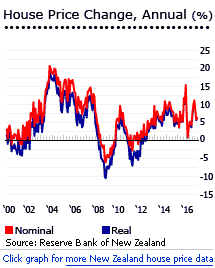 New Zealand’s house prices continue to rise, but at a slower pace, amidst a decline in property demand. However, demand is expected to surge again in the coming months, after a 7.8-magnitude earthquake devastated the country in November 13, 2016, leaving many New Zealanders homeless.
New Zealand’s house prices continue to rise, but at a slower pace, amidst a decline in property demand. However, demand is expected to surge again in the coming months, after a 7.8-magnitude earthquake devastated the country in November 13, 2016, leaving many New Zealanders homeless.
Post-earthquake rebuilding is expected to bolster the housing market.
The nationwide median house price rose by 6.26% to NZ$515,000 (US$366,423) during the year to end-Q3 2016, a sharp slowdown from a year-on-year rise of 15.39% duringthe same period last year, according to the Real Estate Institute of New Zealand (REINZ). When adjusted for inflation, house prices rose by 6.07% y-o-y to Q3 2016.
During the latest quarter, house prices increased 3% (2.87% inflation-adjusted) from the previous quarter.
Despite the overall slowdown, all twelve regions continue to see rising house prices. Nelson/Marlborough recorded the biggest house price rise of 21.6% y-o-y in Q3 2016. Strong house price rises were also seen in Waikato/Bay of Plenty (17.6%), Wellington (16.1%), Northland (15.4%), Taranaki (14.8%), and HawkesBay (14.7%).
Modest to minimal house price rises were also recorded in Auckland (7%), Manawatu/Wanganui (6.9%), Otago(5.7%), Canterbury/Westland (3.4%), Central OtagoLakes (2.7%) and Southland (0.3%).
Auckland has the country’s most expensive housing with an average price of NZ$825,000 (US$586,988), followed by CentralOtagoLakes, with an average price of NZ$694,500 (US$494,137) and Wellington, with an average price of NZ$480,000 (US$341,520). In contrast, Southland has the cheapest housing, with an average price of just NZ$200,000 (US$142,300).
MEDIAN PRICES BY REGION, Q3 2016 |
||||
| Regions | Median price | m-o-m change | y-o-y change | |
| NZ$ | US$ | % | % | |
| Nelson/Marlborough | 450,000 | 320,175 | 4.7 | 21.6 |
| Waikato/Bay of Plenty | 458,500 | 326,223 | 5.4 | 17.6 |
| Wellington | 480,000 | 341,520 | 4.1 | 16.1 |
| Northland | 390,000 | 277,485 | 7.7 | 15.4 |
| Taranaki | 350,000 | 249,025 | 12.9 | 14.8 |
| HawkesBay | 320,000 | 227,680 | 0.0 | 14.7 |
| Auckland | 825,000 | 586,988 | -2.0 | 7.0 |
| Manawatu/Wanganui | 256,600 | 182,571 | 4.1 | 6.9 |
| Otago | 296,000 | 210,604 | 3.9 | 5.7 |
| Canterbury/Westland | 434,250 | 308,969 | 3.4 | 3.4 |
| CentralOtagoLakes | 694,500 | 494,137 | 6.8 | 2.7 |
| Southland | 200,000 | 142,300 | -4.3 | 0.3 |
| NEW ZEALAND | 515,000 | 366,423 | 4.7 | 6.3 |
| Source: Real Estate Institute of New Zealand (REINZ) | ||||
New Zealand saw spectacular house price rises of about 114% (82.6% inflation-adjusted) from 2001 to 2007. Then after a pause, there were four further years of substantial price rises 2012-2015. Because of this, housing in New Zealand has become really expensive, for a country with such a small population relative to its landmass.
Residential construction activity is surging. In the first nine months of 2016, the number of new dwellings consented rose 14.4% to 22,217 units from the same period last year, according to Statistics New Zealand. Likewise, the value of new dwellings consented also increased 18.3% to NZ$893 million (US$635.4 million) in September 2016 from a year earlier.
New Zealand’s economy is projected to expand by a modest 2.8% this year, after growing by 3% in 2014 and 2015, 1.7% in 2013 and 2.8% in 2012, according to the International Monetary Fund (IMF).
Properties available for sale down, days-on-market stable
The number of properties available for sale has continued to fall across all regions, except in Auckland. In Auckland, the level of inventory increased to 12.5 weeks supply in September 2016, from 10 weeks in a year earlier, according to the REINZ.
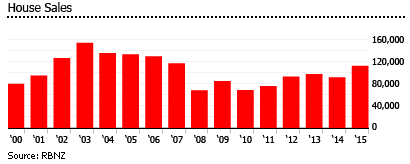
Wellingtonhas the fewest properties for sale across NZ with just seven weeks of supply in September 2016. It was followed by Otago with less than 10 weeks supply, Hawke’s Bay with 10 weeks supply, and Nelson/Marlborough and Waikato/Bay of Plenty, both with 11 weeks supply.
Nationwide, the number of days-on-market was stable at 31 days in September 2016 from a year ago, according to REINZ. Although regionally, six regions saw noticeable improvements, with the number of days-on-market falling by 20% or more. Auckland and Canterbury/Westland were the only two regions to register an increase in the number of days-on-market over the past year.
Property sales in New Zealandfell by 9.5% to 7,397 units in September 2016 from a year earlier, according to the REINZ.
In September 2016:
- In Auckland, sales were down by 23.2% from the previous year
- In Wellington, sales were up 12.5% y-o-y
- In Canterbury, sales were up 10.2% y-o-y
- In Waikato/Bay of Plenty, sales dropped 22.5% y-o-y
Sales of residential properties valued over US$1 million dropped 2.5% in September 2016 from a year ago.
The total value of residential sales, including sections, fell by 5.6% nationwide to NZ$4.89 billion (US$3.48 billion) in September 2016 from the same period last year, according to the REINZ.
New Zealand’s high house prices worry the RBNZ
During the previous housing boom from 2001 to 2007, house prices in New Zealand surged by almost 114% (82.6% inflation-adjusted), including 25% in 2003, 12.2% in 2004, 15.3% in 2005, 9.6% in 2006, and 8% in 2007. Big rises - but then, this was a period when the economy expanded by an average of 3.7% every year.
House prices started to fall in early 2008, but the decline was much less than in other countries:
- In 2008, house prices fell 8.94% (-11.96% inflation-adjusted).
- In 2009, house prices rose by 5.23% (+3.27% inflation-adjusted).
- In 2010, house prices fell by 1.7% (-5.45% inflation-adjusted).
- In 2011, house prices rose by 2.91% (+1.03% inflation-adjusted).
- In 2012, house prices rose by 6.72% (+5.71% inflation-adjusted).
- In 2013, house prices rose by 9.14% (+7.4% inflation-adjusted).
- In 2014, house prices rose again by 6.35% (+5.86% inflation-adjusted)
- In 2015, house prices rose strongly by 11.18% (+10.77% inflation-adjusted)
One reason for strong house price rises from 2012 to 2015 was the healthy expansion of New Zealand’s economy, which grew by an annual average of 2.6%.
A second reason was low interest rates.
A third reason was high immigration.
Non-residents are generally allowed to buy houses in New Zealand. However, purchase of property does not give the buyer the right to live permanently in the country.
Are property prices too high? Maybe not - yields are good.
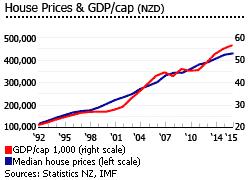
New Zealand’s house prices have been estimated by Deutsche Bank to be 30% overvalued relative to income, and 82% overpriced relative to rents, with Auckland the worst outlier.
New Zealand, particularly Auckland, was rated as “severely unaffordable” with a median multiple of 9.7, according to the 12th Annual Demographia International Housing Affordability Survey:2016. Among the nine developed nations covered by the survey, New Zealand was ranked second most unaffordable major housing market in 2015.
The Demographiasurvey uses the Median Multiple to assess housing affordability in 367 metropolitan markets in Australia, Canada, China (Hong Kong), Ireland, Japan, Singapore, New Zealand, the United Kingdom, and the United States. The Median Multiple follows this formula: Median Multiple = median house prices / median household income.A median multiple of 3.0 and below is considered affordable.
However these assessments of overvaluation and severe unaffordability are contradicted by the Global Property Guide’s own research, which suggests that rental yields in New Zealand’s prime cities are reassuringly high by international standards, and that on this measure, New Zealand’s high residential property prices are amply justified (see below).
Rental yields are very good in Auckland and Wellington, poor in Christchurch
For a developed economy, yields in New Zealand are attractive.
In Auckland, rental yields on apartments range from 6.09% to 7.18%, according to Global Property Guide research conducted last August 2016. The key to getting good yields is smaller apartments, which earn much more than large apartments.
And rental returns on apartments in Wellington have now moved ahead of Auckland. Rental yields ranged from 6.88% to 8.43% in August 2016, with smaller apartments earning more.
In Christchurch, rental returns on houses, which are usually lower than on apartments, range from 2.96% to 4.26% over the same period.
Nationwide, the average rent for new private tenancies rose by 5.6% y-o-y to NZ$380 (US$271) in August 2016, according to New Zealand’s Ministry of Business, Innovation and Employment.
Though average private rents have been generally rising modestly across the country, regional figures show mixed results. In Auckland, the average rent for new private tenancies rose by 4.3% to NZ$480 (US$342) in August 2016 from a year earlier. Over the same period, rents rose in the Wellington region by 6.3% y-o-y to an average of NZ$425 (US$303) while rents dropped by 2.6% y-o-y to NZ$375 (US$268) in Christchurch.
Across the various areas within Auckland, in August 2016:
- In Central Auckland, the average rent was up 4.3% y-o-y to NZ$480 (US$342)
- In Manukau, the average rent was up 4.3% y-o-y to NZ$480 (US$342)
- In the North Shore, the average rent rose slightly by 0.9% y-o-y to NZ$525 (US$375)
- In Waitakere, the average rent rose by 5.6% y-o-y to NZ$475 (US$339)
Immigration is fuelling the housing market
In September 2016, net permanent and long-term immigration were up by 12% to 7,904 people, from 7,069 during the same period last year, according to Statistics New Zealand.
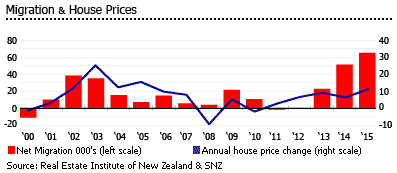
New Zealand’s net immigration rose to 64,930 in 2015 - its highest-ever level - up from 50,922 in 2014 and 22,468 in 2013. From 2005 to 2012, the country’s net immigration averaged only 7,446 people every year, because of the weak economy and low employment opportunities. In contrast, net permanent and long-term immigration was more than 38,000 people 2002, 35,000 in 2003 and 15,000 in 2004.
International migrant flows have a significant impact on house price movements and construction activity in New Zealand. The housing boom of the early-2000s was strongly associated with strong immigration.
New Zealand’s population wsaround 4.65 million in 2015, up from about 4 million recorded in the 2006 census. With a growth rate of 1% per year, its population is projected to reach 5 million by 2020.
Residential construction up
In 2015, residential construction activity was back at pre-crisis levels, with more than 27,000 new dwellings consents, up from 24,700 units in 2014, 21,300 units in 2013, and 16,900 units in 2012.
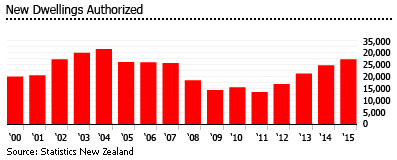
Auckland accounted for 33% of total dwellings authorized and Canterbury for 21% during the first nine months of 2016.In the first nine months of 2016, the number of new dwellings consented rose again by 14.4% to 22,217 units from the same period last year, according to Statistics New Zealand.
Trump’s win prompts RBNZ to cut rates
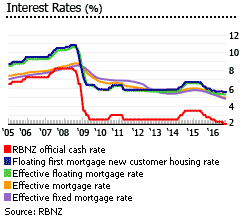
The RBNZ recently reduced its official cash rate (OCR) to a record low of 1.75%, in the wake of Donald Trump’s US election win. Justifying the cut, RBNZ Governor Graeme Wheeler noted: “Political uncertainty remains heightened and market volatility is elevated.”
If U.S. President-elect Donald Trump pushes through with campaign promises of a more closed approach to trade, New Zealand’s trade-reliant economy will be adversely affected.
“New Zealand is so dependent on international trade that anything a Trump presidency did to slow world trade would have an impact on New Zealand,” said former New Zealand prime minister Jim Bolger.
It was in July 2008 that the RBNZ dramatically reversed gear and lowered interest rates, after a period of rising interest rates beginning in 2003. By April 2009 the key rate was down a record low 2.5%, where it remained until May 2010.
The RBNZ raised the key rate by 25 basis points in May 2010, and by another 25 basis points to 3% in July 2010. However in March 2011, the key rate was cut to 2.5% after the Christchurch quake of February 2011. The RBNZ left the OCR unchanged at 2.5% until February 2014. However in July 2014 the RBNZ increased the OCR to 3.5%. Now the rate is back down again. The RBNZ cut the OCR by 25 basis points to 2% in August 2016, after cutting it five times in the past 14 months, to boost economic growth.
Mortgage lending on the rise, again
The mortgage market soared from just 51.4% of GDP in 1998, to 86% of GDP in 2015.In September 2016, the total value of outstanding housing loans rose again by 9.2% y-o-y.
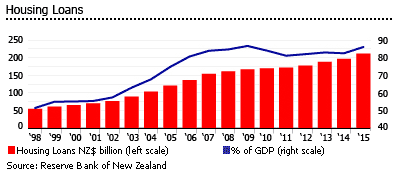
Mortgage rates in September 2016:
- Floating mortgage rate: 5.31%, down from 5.83% a year earlier
- Fixed mortgage rate: 4.85%, down from 5.57% a year earlier
Solid economic growth, but currency weakness ahead?
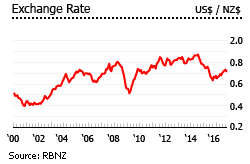
New Zealand’s economy is expected to expand by a modest 2.8% this year and by another 2.7% in 2017, according to the IMF. Economic growth was 3% both in 2014 and 2015, the strongest performance since 2007, according to the International Monetary Fund (IMF).
After the Asian financial crisis New Zealand experienced years of unbroken economic growth. The economy grew by an average of 3.8% per year from 1999 to 2007.
During the recent global crisis the economy contracted only briefly and mildly - by 0.4% in 2008. The economy grew slightly by 0.3% in 2009. New Zealand emerged swiftly from recession, after only five quarters of negative GDP.
The kiwi gained 13% against the US dollar in just 13 months toOctober 2016, after reaching a six-year low in September 2015. However in September 2016, the country’s trade deficit widened to NZ$1.44 billion (US$1.02 billion), up by 26% from a year earlier and the biggest trade gap since the series started in 1951. This could suggest future currency weakness.
External debt low, unemployment low, inflation low
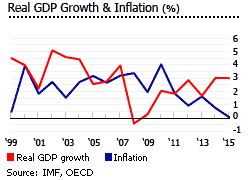
New Zealand’s net external debt is low, at about 24.6% of GDP (2015-2016), slightly down from 25.1% of GDP in the previous fiscal year.
Unemployment stood at 4.9% in Q3 2016. From an average of 8% from 1990 to 2000, the country’s jobless rated dropped to an average of 5% from 2001 to 2015, according to the IMF.
In the third quarter of 2016 inflation stood at 0.4%, well below the central bank’s target range of 1% to 3%.